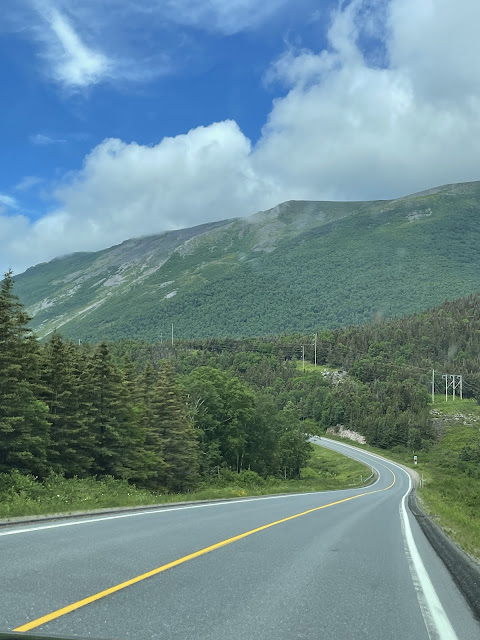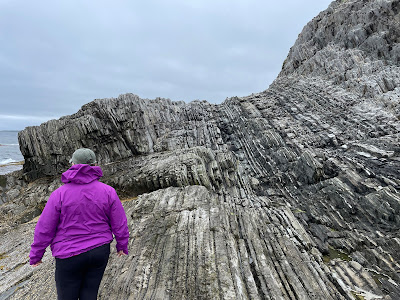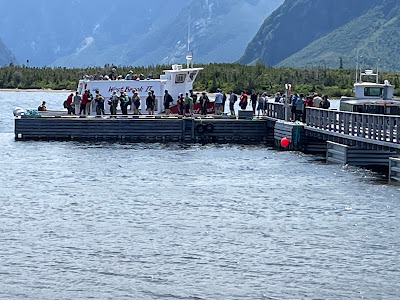Gros Morne National Park is a big place. It’s perched on the western side of Newfoundland, and it holds a lot of history. Both in human records and in geological eras. It encompasses 5 villages and many different types and ages of rock. There are so many diverse parts, that it’s hard to explain it in just one go. But I’ll try.
The biggest area on the southern end of the park is called the Tablelands. It is a flat, orangey range that appears desolate and empty of life, especially in comparison to the green hills around it. It has actually been used to represent Mars!
The geological importance of this range is that it’s considered to be the oldest rock visible on earth. It was pushed up from the mantle, which is below the earth’s crust and just above the earth’s core. A freshly broken chunk of rock from here is a very dark green colour, but it oxidizes in the air and becomes a rusty shade over time.
The trail to the base is a very popular walk, and because there is no vegetation to disturb, one is allowed to climb to the top if one really wants to attempt the scramble. With warnings posted that rocks could shift at any time.
With rocks being the name of the game here, we also walked the coastline around Green Point. The shale sedimentary rocks from the bottom of an old sea alternating with ribbons of limestone had been pushed up vertically along these cliffs, exposing them to geologists and tourists alike. The geologists at least are very enthusiastic about these cliffs as they hold fossils from two different geological eras.
But however interesting they are, I found them very hard to walk across. The shale was in thin strips and very sharp.
An easier trip that we took was to the Western Brook Pond. It involved a boat trip. The boat was smaller than I had expected, with a safe capacity (or so I was told) of 99 people. There were not 99 seats on the boat.
Not that it mattered, because most of the passengers were trying to crowd themselves to the front or the back just to get the best views. I’m pretty short. I got the best views of other people.
Nonetheless, the views I did get were stupendous with towering cliffs over the water.
And finally, there is Gros Morne. The mountain that the park is named after. When we first arrived, it was a very foggy day. Based on the map I was following, I gestured to the right at the proper time and said, “there’s a big mountain there!”, knowing that all we could see was white fog.
It was almost disappointing when the fog lifted and we saw the round mass of Gros Morne. It is nothing like the craggy and steep forms that surround it. Yes, it is big, but far from imposing.
That is, until you try to hike it. I attempted the first half, but gave up. And I hadn’t even reached the bottom of the mountain. You have to hike four and a half kilometres, uphill, only to reach the point where they post warnings about continuing to the top. The warnings make clear that it’s a one way loop around from there, meaning even if you give up, you can’t turn around and go back. The entire trek is 17.4 kms.
Although I conceded defeat, my hubby went back early the next morning determined to reach the summit. Beyond the several warnings, there are loose rocks to scramble over.
With no soil, you have to rely on arrows pointing the route. I’m proud to say he made it to the top, and all before his breakfast.
But if going up was bad, so was the return trip. I understand the view was wonderful up there, not that it encourages me to attempt the task.
I certainly haven’t been able to describe all that we saw and did in our 10 days in Gros Morne. We were able to spend time in most of the seaside villages. Hubby took a couple of park ranger guided tours on plants used by the natives for medicines and healing.
We stayed in one of four campgrounds inside the park. The water provided had a lovely tinge of brown, and we were told to boil before drinking. But along the highway we found a spring gushing out of the cliffs. Fresh, clear, and cold. And since we had to boil anyway, it just made sense to use the stuff that at least looked good. Trust me, we weren’t the only ones. The spring had a parking space and a wooden plank to put your bottles on. And occasionally, a lineup.
We didn’t always hike just for the views. Oft times, it was the best way to get a cell signal.
Gros Morne Park is a big place, after all.
W














No comments:
Post a Comment